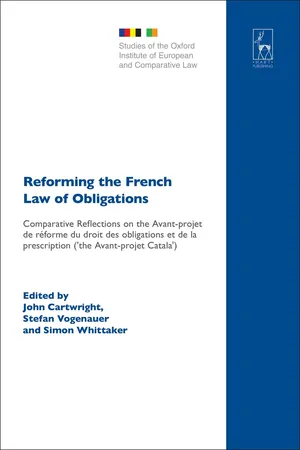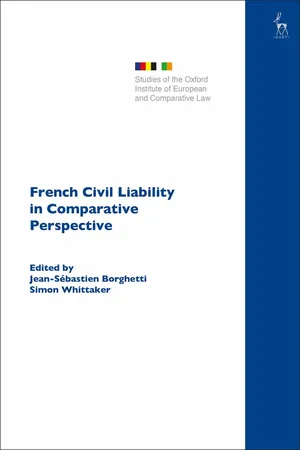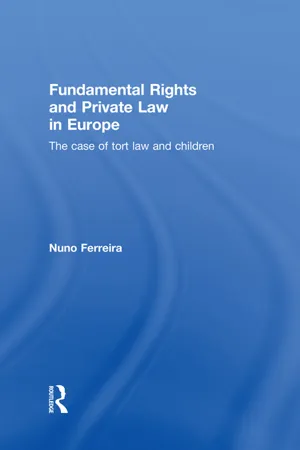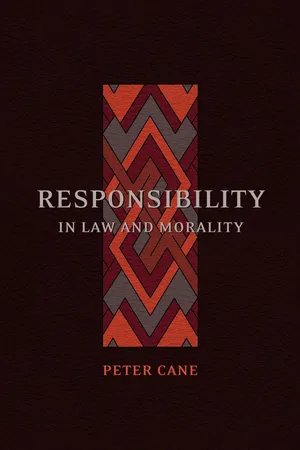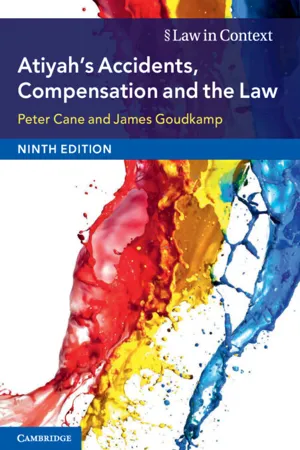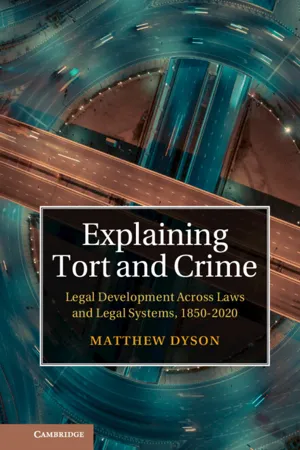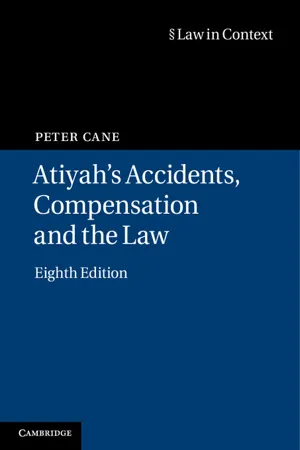Law
Fault in Law
Fault in law refers to the legal responsibility or liability for a wrongful act or omission. It is a key concept in tort law, where determining fault is essential for establishing liability and awarding damages. Fault can be based on negligence, intentional wrongdoing, or strict liability, and it plays a crucial role in legal proceedings and the administration of justice.
Written by Perlego with AI-assistance
Related key terms
1 of 5
8 Key excerpts on "Fault in Law"
- eBook - PDF
Reforming the French Law of Obligations
Comparative Reflections on the Avant-projet de réforme du droit des obligations et de la prescription ('the Avant-projet Catala')
- John Cartwright, Stefan Vogenauer, Simon Whittaker, John Cartwright, Stefan Vogenauer, Simon Whittaker(Authors)
- 2009(Publication Date)
- Hart Publishing(Publisher)
12 The Definition of la faute in the Avant-projet de réforme JEAN-SÉBASTIEN BORGHETTI F AULT IS ONE of those concepts that jurists find particularly diffi-cult to define because they are not exclusively legal notions: legal or juridical fault is just one type of fault among many others and co-exists with moral fault, political fault, fault in a sporting context, etc. All these particular types of fault are often seen as various instances of a single overarching category. It is true that the basis for such an essentialist posi-tion which would postulate the existence of an absolute concept of fault without any qualification or modification is debatable. Nevertheless, it is clear that the word ‘fault’ forms a part of everyday language and that, as such, it has a significance which is not primarily juridical. Fault is certainly not the only term borrowed from everyday language which is employed to designate a legal concept. The law of civil liability is indeed very rich—though no more so than the other branches of the law— in these ambiguous concepts which first have significance for the generality of human beings before they identify a particular legal concept: harm, causation or indeed defectiveness are further examples, along with fault. It is inevitable as well as desirable that the law should borrow from everyday language some, indeed the majority, of the terms that it uses. That expresses the link between law and the reality for which it is called to provide structure, reinforcement and direction—a link which should be unbreakable. These concepts, which are in a certain sense at the crossroads between everyday language and legal language, nevertheless create particular diffi-culties in terms of their definition. Their legal meaning must be clearly distinguished from their ordinary meaning. - Jean-Sébastien Borghetti, Simon Whittaker, Jean-Sébastien Borghetti, Simon Whittaker(Authors)
- 2019(Publication Date)
- Hart Publishing(Publisher)
7 If we do not know the boundaries of fault, how do we know, in the final reckoning, how much value to place on article 1241? The definition of fault is therefore of great interest and this interest can only be increased by its analysis through the prism of comparative law, and especially of English law.It might seem strange to say this, because it is clear that fault is not a very commonly used concept in English law.8 The explanation is probably to be found in the origins of the law of tort, which derives directly from the procedural system of writs. To bring an action, it used to be necessary to obtain a writ from the Lord Chancellor and the number of these writs was limited, with each having its own requirements of both form and substance. Over time, the writs were given names and thus different situations of liability, different ‘torts’, came into being.9 Today, there are dozens of them, each with its own regime and aimed at the protection of a particular interest.10 This explosion of civil liability by means of a multitude of individual wrongs makes it impossible to find a single concept of fault as a condition for recovery of compensation. Looked at more closely, it can be seen more as a justification for imposing liability.11 One qualification on this general picture must be made, however, owing to the tort of negligence, which experienced tremendous growth during the twentieth century, and where liability is based on ‘breach of a duty of care’. This is reminiscent of the fault with which French lawyers are familiar – and it makes comparison less difficult.This is good, because the comparison is quite fruitful. As a matter of intuition, we could expect that the French definition would seem rather restrained to the lawyer in a common law system, for whom the establishment of negligence is a subtle exercise.12- eBook - ePub
Fundamental Rights and Private Law in Europe
The Case of Tort Law and Children
- Nuno Ferreira(Author)
- 2011(Publication Date)
- Routledge(Publisher)
While this might under certain circumstances and in certain jurisdictions hold more truth than in others, it does seem to be a relatively valid statement for tort law in all jurisdictions (Jourdain 1994 : 17–20). In sum, although negligence does assume a much more important role in tort law than in criminal law, the different degrees of fault in tort law possess more importance than is usually believed. Most important for our subject matter, the interests of society may require tortious intention to justify the imposition of liability. This is to say that, in some contexts, a wrongdoing should only have as a consequence the payment of damages if the tortfeasor has acted intentionally. These contexts are those where the interests of the tort victims have to yield to wider social interests. As Cane puts it, ‘[w]hen a harm-causing activity has high social value, a requirement of intention for tort liability helps to protect society’s interest in the continuance of that activity’ (Cane 2000). This fine balance between ‘victim-security, agent-autonomy and social value’ might, therefore, justify imposing liability independently of negligence, as well as excluding liability for negligent acts in certain contexts. In conclusion, the role of fault in tort law has changed substantially throughout time. The controversy around this role has allowed scholars to talk about the ‘decay of fault’ (Viney 1965 : 203–344; Jourdain 1994 : 17–20). However, it is arguably still generally valid that personal responsibility is based on an individual’s fault or guilt. One simply has to be willing to accept that the exact scope and nature of this rule is dynamic and subject to changes - eBook - PDF
- Peter Cane(Author)
- 2002(Publication Date)
- Hart Publishing(Publisher)
But the criminal law paradigm is more sensitive to luck than the civil law paradigm at the level of sanctions. I hypo-thesised in 2.4.1 that the civil law and criminal law paradigms of legal res-ponsibility broadly reflect moral principles of responsibility. If this hypothesis is Responsibility and Culpability 77 48 Similarly: Shaver (1985), 82–3. 49 Ashworth (2000), 123–8, 139–40; Walker and Padfield (1996), 50–1, 55, 314; Morse (1993), 242. The reduction of murder to manslaughter on grounds of diminished responsibility illustrates the same point. 50 For the suggestion that criminal law ought to be more sensitive to circumstantial luck than civil law see Law Commission (1996), para. 4.33; Ashworth (1993). correct, it supports the earlier conclusion that our moral responsibility prac-tices, like our legal responsibility practices, make only limited allowance for dis-positional luck. 3.3 CRITERIA OF LEGAL LIABILITY 3.3.1 Fault 3.3.1.1 Components of fault criteria Legal criteria of fault have two types of components: mental elements and standards of conduct. Legal fault consists either of failure to comply with a spec-ified standard of conduct, or of failure to comply with a specified standard of conduct accompanied by a specified state of mind. 51 Legal fault criteria may relate to conduct or to outcomes (or to both). The term “conduct” refers to both acts and omissions; and it connotes acts and omissions described not in terms of bodily movements (or their absence), but in terms of some legal category. In other words, “conduct” connotes acts and omissions plus what might be called their “definitional” consequences. 52 For instance, trespass to land may consist of the bodily movements involved in walking onto land, plus the definitional con-sequence of entering the land of another without their consent. “Outcomes” refers to what might be called “extrinsic” consequences. - eBook - PDF
- Peter Cane, James Goudkamp(Authors)
- 2018(Publication Date)
- Cambridge University Press(Publisher)
In the criminal law, it is seen as a basic requirement of justice that ‘the punishment fit the crime’ in terms of the seriousness of both the offender’s conduct and the consequences of that conduct. In tort law, on the other hand, there is no such idea that the compensation payable should be proportional to the tortfeasor’s fault. 1 Fault is like a magic talisman: once it is established, all shall be given to the injured party. It is generally immaterial whether the fault was gross or trivial, 2 or whether the consequences of the fault 1 This contrast between the criminal law and tort law is explored in P. Cane, ‘Retribution, Proportionality, and Moral Luck in Tort Law’ in P. Cane and J. Stapleton (eds), The Law of Obligations: Essays in Celebration of John Fleming (Oxford, 1998) 141. 2 There are some exceptions. For example, people are expected to take more care for the safety of others than for their own safety, and adults are expected to take more care of their own interests than children. In some cases, too, a defendant will be held liable for negligence only if their 164 An Appraisal of the Fault Principle were catastrophic or minor. A degree of fault on the part of someone results in the injured person being compensated for all the losses suffered, provided the claimant was in no way personally at fault. Yet the seriousness of the consequences of a negligent action often bears no relation to the degree of fault which gave rise to it. A piece of momentary thoughtlessness on the road may cost someone their life and cause great loss to their family; but similar acts of thoughtlessness – or much more serious acts of negligence – may be committed by scores of others every day with only minor or even no adverse consequences. - eBook - PDF
Explaining Tort and Crime
Legal Development Across Laws and Legal Systems, 1850–2020
- Matthew Dyson(Author)
- 2022(Publication Date)
- Cambridge University Press(Publisher)
185 In sum, in Spain, subjective fault concepts remain vital to criminal law, having waned then partially recovered some importance in civil law. The fault concepts are similar to each other even without discussion of their being unified. According to Santos Briz, there are some key differences between the two types of fault. 186 Criminal concepts of fault have pre- cluded strict liability in general; as part of the argument that all law still has a ‘moral’ connection, criminal fault has a stronger claim, whereas morality is ‘further from’ civil concepts of fault; the purpose of tort law is 183 E.g., STS 10 octubre 2006 (Sentencia 936/2006). 184 E.g., STS 10 marzo 1962 [1962] RJ 1234. 185 Quintano Ripollés, ‘Diferenciación’, 1051–2, and see generally 1051–4, as a quotation from STSS 13 noviembre 1934, 2 febrero 1940 and 22 noviembre 1940. 186 Santos Briz, ‘La culpa’, 636–40. 274 the development of fault doctrine in crime & tort compensatory, and fault follows that aim, while criminal fault is not linked to subsequent physical or property harm, but with a penalty for wrongdoing; 187 criminal law requires imputability and responsibility for one’s own actions; causation plays less of a role in criminal law concern- ing property damages than it does in tort law; by contrast, criminal law’s conditions of unlawfulness are more tightly constrained through tipicidad, 188 leaving less invitation for fault to muddy the conceptual work; civil fault extends to less culpable behaviour than criminal fault; and finally, criminal fault is analysed more subjectively, that is, in con- creto in Roman terms, compared with civil law’s objective in abstracto analysis. 4 United States of America and Other Common Law Jurisdictions The development of fault in state and federal legal systems within the USA is too large a project for this chapter, especially since both tort and crime have strong state-level content, with federal layers on top. - eBook - ePub
- Mary Charman, Bobby Vanstone, Liz Sherratt(Authors)
- 2012(Publication Date)
- Willan(Publisher)
Part 4 The Concept of LiabilitySo far this book has investigated the way in which the English legal system operates, including the way in which the law is formed, the courts and the people who work in them, the role played by the police, etc. The next part of the book provides an introduction to aspects of three areas of substantive law (specific areas of practical law which create rights and obligations):- criminal law
- the law of tort and
- contract law
The material studied in this part of the book will be useful not only for the purposes of the second ‘half’ of AS law for AQA students, but also in providing you with illustrations and examples to support your previous studies, as well as introducing you to particular rules of law.Central to this part of the book is the concept of liability. The term ‘liability’ means responsibility for a person's actions towards others in society, whether in civil or criminal law. A wrongful act that breaches the criminal law creates a criminal liability and an offender may then be found guilty. A wrongful act that breaches the law of tort or contract creates a civil liability and the person carrying out that act may be found liable to compensate in some way the person to whom the harm was caused. The distinction between civil and criminal is discussed in the following chapters, although some differences have already arisen in Chapter 7 (the court system). In general the criminal law is concerned with upholding a standard of behaviour by punishing those who offend, whilst the civil law is concerned with compensating the victim.This part of the book is only an introduction to these areas of substantive law. For students continuing to A2 level, the topics are developed further in the relevant modules of the A2 specification. AQA candidates should be able to explain the rules of law covered here, and apply them to a factual problem situation. The topics will then be developed further at A2. OCR candidates continuing to A2 will choose to study, in greater depth, only one - eBook - PDF
- Peter Cane(Author)
- 2013(Publication Date)
- Cambridge University Press(Publisher)
4 Departures from the fault principle 4.1 Fault liability and strict liability The fault principle, as embodied in the concept of negligence, is not the only basis of legal liability for personal injuries and death, although it is, in practice at least, by far the most important. In this chapter, we will consider modifications to and departures from the fault principle. Such modifications and departures are often said to impose ‘strict liability’ as opposed to fault liability. Whereas fault liability is based on a judgment that a person should have behaved differently (for instance, by taking certain precautions), strict liability does not involve any judgment that the person should have behaved differently. Putting the same point another way, fault liability is liability for the way a person behaved, whereas strict liability is liability for consequences of a person’s conduct. Strict liability has often been thought to be morally unjustifiable, even if it has its uses as a legal device – how can it be fair to hold someone liable for the consequences of behaving in a perfectly acceptable way? How can we justify liability in the absence of culpability? The best answer to this question appears to be that even in morality (as opposed to law) we sometimes accept responsibility and hold others responsible for things that were not our, or their, fault. For example, if a young child accidentally breaks a neighbour’s window while playing ball, its parents might well feel that they ought (morally) to accept responsibility for the broken window and pay to have it replaced, even if they took all reasonable care in supervising their child. Indeed, this example shows that morality might impose strict liability in situations where the law would not – the parents would not be legally liable for the damage done by the child in such a case. So it may be fair to hold someone liable for the consequences of their conduct even if that conduct was not faulty.
Index pages curate the most relevant extracts from our library of academic textbooks. They’ve been created using an in-house natural language model (NLM), each adding context and meaning to key research topics.
